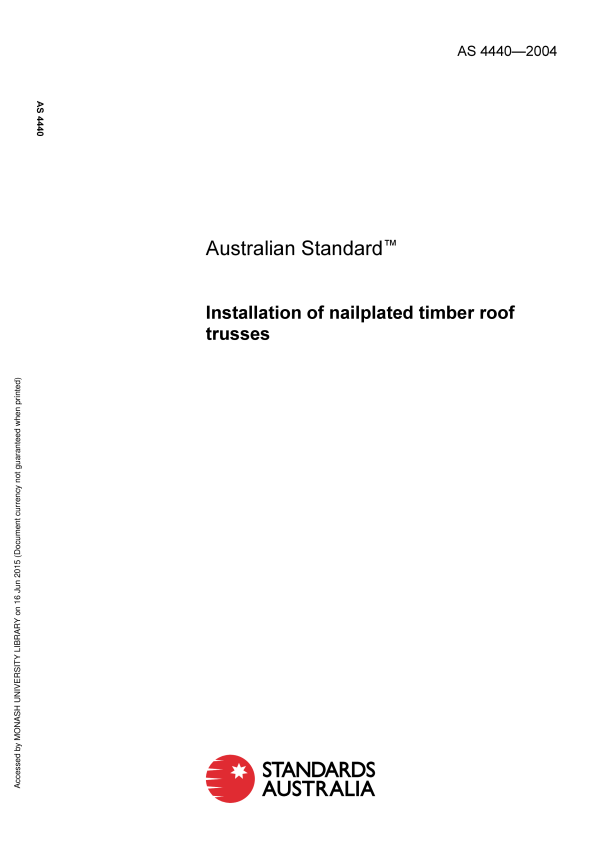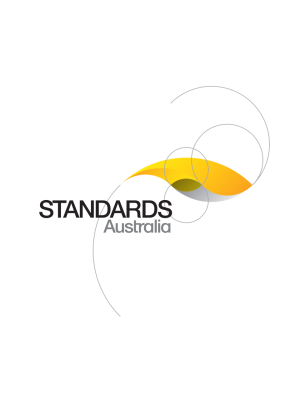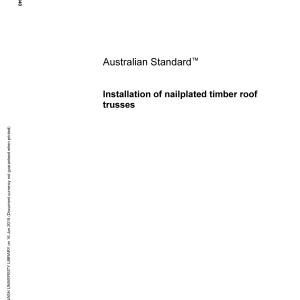Header
About this publication
PREFACE
1 SCOPE AND GENERAL
1.1 SCOPE
1.2 APPLICATION
1.3 REFERENCED DOCUMENTS
1.4 USE OF ALTERNATIVE MATERIALS OR METHODS
1.5 DEFINITIONS
1.6 LOADS
1.7 DOCUMENTATION AT APPROVAL STAGE AND DELIVERY
1.8 NAILS
2 SUPPORTING STRUCTURES
2.1 GENERAL
2.2 WALLS
2.2.1 Loadbearing walls
2.2.2 Non-loadbearing walls
2.2.3 Fixing to top plates of non-loadbearing walls
3 TRUSS INSTALLATION
3.1 TRUSS LAYOUT
3.2 STABILITY DURING INSTALLATION
3.3 TEMPORARY BRACING
3.4 INSTALLATION TOLERANCES
3.4.1 General
3.4.2 Bow
3.4.3 Plumb
3.4.4 Spacing
3.5 PLASTERBOARD FIXED DIRECTLY TO BOTTOM CHORDS
3.6 INTERMEDIATE CEILING JOISTS
3.7 TIE-DOWN REQUIREMENTS
3.8 MULTIPLE (MULTI-PLY) TRUSS
3.9 TRUSS MODIFICATION
3.10 REJECTION CRITERIA
3.11 TRANSPORT, STORAGE, LIFTING AND HANDLING
4 ROOF BRACING
4.1 GENERAL
4.2 ROOF BATTENS
4.2.1 General
4.2.2 Intermediate and internal top chord ties
4.2.2.1 Intermediate top chord ties for valley intersection
4.2.2.2 Internal top chord ties for north-light or similar trusses
4.2.2.3 Internal top chord ties for top-hat trusses
4.3 TOP CHORD BRACING
4.3.1 General
4.3.2 Steelbrace
4.3.3 Steelbrace for gable roof
4.3.3.1 General
4.3.3.2 Truss spans up to 8 m
4.3.3.3 Truss spans of 8 m to 13 m
4.3.3.4 Truss spans 13 m to 16 m
4.3.4 Steelbrace for hip roof
4.3.4.1 Bracing requirement for standard trusses
4.3.4.2 Bracing requirement for jack trusses
4.3.5 Steelbrace for dual-pitched roof
4.3.6 Steelbrace for bell roof
4.3.7 Steelbrace for mono-pitched roof
4.3.8 Fixing
4.4 BOTTOM CHORD BRACING
4.4.1 General
4.4.2 Bottom chord lateral restraints
4.4.2.1 Battened ceiling
4.4.2.2 Suspended or no ceilings
4.4.2.3 Bottom chord ties for construction
4.5 WEB BRACING
5 TRUSS CONNECTION
5.1 GENERAL
5.2 HIP ENDS
5.2.1 Hip-end connection for low wind area (wind classification N1, N2, N3, OR C1)
5.2.2 Hip-end connection for high wind area (wind classification N4, C2 or C3)
5.3 GIRDER TRUSSES
5.3.1 Girder brackets (truss boots)
5.3.1.1 General
5.3.1.2 Framing bracket (joist hanger)
5.3.1.3 Standard truss boot
5.3.1.4 Anti-twist truss boot
5.3.1.5 High-load truss boot
5.3.2 Waling plates for Dutch-hip girder
5.4 VALLEY (SADDLE) TRUSSES
5.4.1 Valley truss connection for wind classification N1, N2, N3 or C1
5.4.2 Valley truss connection for wind classification N4, C2, OR C3
6 TRUSS OVERHANGS
6.1 STANDARD TRUSS-OVERHANGS
6.1.1 General
6.1.2 Raking eaves in hip corner
6.1.3 Boxed eaves
6.1.3.1 Propped boxed eaves
6.1.3.2 Non-propped boxed eaves
6.2 GABLE VERGE
6.2.1 Gable-end truss
6.2.1.1 General
6.2.1.2 Gable-end truss sitting on or supported by the end wall
6.2.1.3 Gable-end truss, free spanning
6.2.2 Verge overhang
6.3 BOXED GABLE ENDS
6.4 VERANDAHS
6.5 PERGOLAS
APPENDIX A
A1 INTRODUCTION
A2 APPROVAL STAGE
A3 DELIVERY
A4 CHECK LIST
APPENDIX B
B1 INTRODUCTION
B2 CAMBERS
B3 FIXING OF CORNICE
B4 BEARING WIDTH
APPENDIX C
C1 GENERAL
C2 HIP OR DUTCH-HIP END ROOF
C3 GABLE-END ROOF
APPENDIX D
D1 GENERAL
D2 SIZE
D3 CONNECTION
APPENDIX E
E1 GENERAL
E2 TRANSPORT
E3 STORAGE
E4 LIFTING AND HANDLING
APPENDIX F
APPENDIX G



